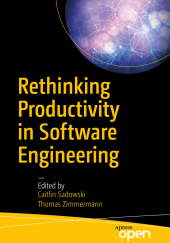 Neuerscheinungen 2019Stand: 2020-02-01 |
Schnellsuche
ISBN/Stichwort/Autor
|
Herderstraße 10
10625 Berlin
Tel.: 030 315 714 16
Fax 030 315 714 14
info@buchspektrum.de |

Caitlin Sadowski, Thomas Zimmermann
(Beteiligte)
Rethinking Productivity in Software Engineering
Herausgegeben von Zimmermann, Thomas; Sadowski, Caitlin
1st ed. 2019. xxviii, 310 S. 50 SW-Abb. 254 mm
Verlag/Jahr: SPRINGER, BERLIN; APRESS 2019
ISBN: 1-484-24220-3 (1484242203)
Neue ISBN: 978-1-484-24220-9 (9781484242209)
Preis und Lieferzeit: Bitte klicken
Get the most out of this foundational reference and improve the productivity of your software teams. This open access book collects the wisdom of the 2017 "Dagstuhl" seminar on productivity in software engineering, a meeting of community leaders, who came together with the goal of rethinking traditional definitions and measures of productivity.
The results of their work, Rethinking Productivity in Software Engineering , includes chapters covering definitions and core concepts related to productivity, guidelines for measuring productivity in specific contexts, best practices and pitfalls, and theories and open questions on productivity. You´ll benefit from the many short chapters, each offering a focused discussion on one aspect of productivity in software engineering.
Readers in many fields and industries will benefit from their collected work. Developers wanting to improve their personal productivity, will learn effective strategies for overcoming common issues that interfere with progress. Organizations thinking about building internal programs for measuring productivity of programmers and teams will learn best practices from industry and researchers in measuring productivity. And researchers can leverage the conceptual frameworks and rich body of literature in the book to effectively pursue new research directions.
What You´ll Learn
Review the definitions and dimensions of software productivity
See how time management is having the opposite of the intended effect
Develop valuable dashboards
Understand the impact of sensors on productivity
Avoid software development waste
Work with human-centered methods to measure productivity
Look at the intersection of neuroscience and productivity
Manage interruptions and context-switching
Who Book Is For
Industry developers and those responsible for seminar-style courses that include a segment on software developer productivity. Chapters are written for a generalist audience, without excessive use of technical terminology.
Rethinking Productivity in Software Engineering
Part I: Introduction to Productivity
1. The Mythical 10x Programmer
2. No Single Metric Captures Productivity
3. Why We Should Not Measure Productivity
Part II: Introduction to Productivity
4. Defining Productivity in Software Engineering
5. A Software Development Productivity Framework
6. Individual, Team, Organization, and Market: Four Lenses of Productivity
7. Software Productivity Through the Lens of Knowledge Work
Part III: The Context of Productivity
8. Factors That Influence Productivity: A Checklist
9. How Do Interruptions Affect Productivity?
10. Happiness and the Productivity of Software Engineers
11. Dark Agile: Perceiving People as Assets Not Humans
Part IV: Measuring Productivity in Practice
12. Developers´ Diverging Perceptions of Productivity
13. Human-Centered Methods to Boost Productivity
14. Using Biometric Sensors to Measure Productivity
15. How Team Awareness Influences Perceptions of Developer Productivity
16. Software Engineering Dashboard: Types, Risks, and Future
17. The COSMIC Method for Measuring the Work-Output Component of Productivity
18. Benchmarking: Comparing Apples to Apples
Part V: Best Practices for Productivity
19. Removing Software Development Waste to Improve Productivity
20. Organizational Maturity: The Elephant Affecting Productivity
21. Does Pair Programming Pay Off?
22: Fitbit for Developers: Self-Monitoring at Work
23: Reducing Interruptions at Word with FlowLight
24: Enabling Productive Software Development by Improving Information Flow
25: Mindfulness as a Potential Tool for Productivity


